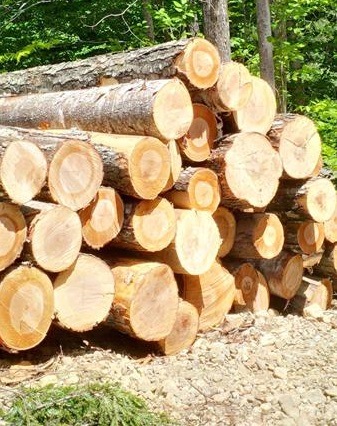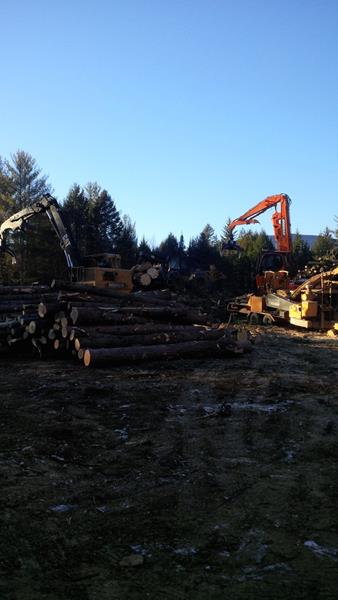NH & VT Timber Prices - Fall 2016

With the fall season behind us now is a good time to do a quick reviews of how the timber markets have been. One word: challenging! Over the course of the summer we saw a further reduction in the markets for biomass chips and pulpwood. At the same time, production on the part of the Northeast logging community, thanks to historically dry conditions, allowed for exceptionally high production volumes of all grades of wood. The result: massive overcapacity. The mills ( particularly pulp and biomass) just don’t need the volume of wood that is being currently being produced. However, it will eventually be balanced out… it will just take time. That said, there does continue to be few bright spots. White Pine grade saw logs is one of them.
Below is a summary of the various regional wood products, broken down by species category
Hardwood Logs :
Hardwood saw logs, pallet and veneer have all remained steady this past summer and into the fall. The prices paid by the mills, to our main logging contractor have remained consistent throughout this time period. This has benefited our clients immensely during a time when most other forestry firms struggle to even sell what it is being produced. Although the prices are lower than they were a year ago. They are still very competitive given the tough market conditions. In fact the Red Oak prices that our clients have been receiving are relatively unchanged from the market highs of two years ago. The biggest change this upcoming winter will be seen in the hardwood pallet grade markets. The largest , North American, manufacturer of wooden matts ( for mining/ ultility work etc..) – just pulled the plug on the purchasing of all matt timbers from all New England lumber manufacturers. Reasons behind this remain murky.
However, whatever the reason may be, the effects of it will reverberate throughout the industry. Nearly every hardwood lumber manufacturer in this region has a portion of their sales tied to this company. They will now be left to figure out what to manufacture that lower grade of hardwood log into. Prices for this grade of log will also drop significantly. Many mills were paying a delivered price of $ 300 p./mbf. for this low grade of log. This will not continue. With the restricted market and reduced delivered pricing, you will also see more logging contractors diverting their pallet grade logs into the pulpwood pile. This will put further strain on an already flooded pulpwood market.
Softwood Logs:
White Pine:
 As mentioned previously, this appears to be one of the brightest spots in the New England wood marketplace. The demand for the raw log has been steady and prices have remained competitive. Our main logging contractor is one of the largest suppliers to a major regional white pine mill. This has enabled him to deliver to them without restriction at consistent, competitive pricing. This stability has benefitted the clients of Stillwater Forestry LLC with very competitive prices being paid for their white pine timber. We see no changes with this - going into the winter. The manufacturers of white pine lumber have seen the market for their finished product free of significant volatility over the course of the last year and half. This is in stark contrast to the hardwood lumber markets. A point was made recently by a veteran hardwood lumber seller, that the reason for this is because the pine lumber manufacturers are selling, nearly exclusively, into the US market. Here, in the states, contracts are honored, there is better control over supply and demand and the tendency to drop a supplier, without notice, over minute price differences is absent. In the foreign markets, where most of our hardwood lumber is sold, this is not always the case. In turn this leads to a lot more market volatility.
As mentioned previously, this appears to be one of the brightest spots in the New England wood marketplace. The demand for the raw log has been steady and prices have remained competitive. Our main logging contractor is one of the largest suppliers to a major regional white pine mill. This has enabled him to deliver to them without restriction at consistent, competitive pricing. This stability has benefitted the clients of Stillwater Forestry LLC with very competitive prices being paid for their white pine timber. We see no changes with this - going into the winter. The manufacturers of white pine lumber have seen the market for their finished product free of significant volatility over the course of the last year and half. This is in stark contrast to the hardwood lumber markets. A point was made recently by a veteran hardwood lumber seller, that the reason for this is because the pine lumber manufacturers are selling, nearly exclusively, into the US market. Here, in the states, contracts are honored, there is better control over supply and demand and the tendency to drop a supplier, without notice, over minute price differences is absent. In the foreign markets, where most of our hardwood lumber is sold, this is not always the case. In turn this leads to a lot more market volatility.
Spruce:
Market demand for NELMA grade studs and 2x4’s is stable. Neither prices or demand are near historic highs however, both remain steady and look to remain this way through the winter. The drought level conditions we experienced this past summer enabled logging contractors to produce vast volumes of all amounts of wood. Spruce and fir was no exception. By late August all of the dimension softwood mills both here in the states and over the border in Canada were full. Price drops and quotas followed. In fact one major domestic mill in NH took the unprecedented step of paying a lower price for delivered fir logs and only taking them if they were cut exact length. The assumption being that fir produces a lower yield per log than red spruce. Regardless, we think that seeing grades in dimensional softwood logs is a first.
Hemlock:
With the loss of a steady market for softwood pulp, logging contractors set their sites on turning as much of their harvested hemlock trees into logs. In fact, the scaler/wood buyer for one large purchaser of hemlock logs mentioned that he noticed a significant drop in log quality compared to times past. He also mentioned that he had received more first time calls from contractors looking to deliver logs than he could remember in his 20 years doing the job. The result – all of the hemlock mills are filled to capacity. This is the case both in the states and in Canada. Two of the largest purchasers of hemlock logs – based in Quebec – have ceased buying hemlock logs indefinitely. One of the owners stated in December 2016, he had enough logs to saw fulltime until June 2017 , without purchasing any additional wood. The remaining domestic mills that continue to purchase logs are doing so only from regular suppliers and according to strict quota.
Pulp/Firewood/Biomass
The low grade markets continue to pose the biggest challenge of all.
Hardwood Pulp:
Although the markets have opened up a bit compared to the last six months of strict quota, delivered prices are down. Distance to the mill, for the first time in years, is now a factor. The mills are looking to purchase as much of their wood from within a 50 mile ( or less ) radius from their facilities. For some of the largest consuming mills this is not an option so they continue to purchase from points further away albeit on a very restricted basis. Many of the pulp/paper manufacturers are also now in a position to give purchasing preference to those producers with third party certified (FSC) wood to sell. If harvested wood is close to the mill and comes from FSC certified lands preference one can expect to deliver without restriction. Uncertified wood from further distances can expect to see tight quota – assuming they’re allowed to deliver at all.
Softwood Pulp:
Since last year, the market for this product has been severely curtailed. With one large pulp mill in Maine cutting their production in half and just recently announcing a further reduction of 25% - the market will only continue to constrict. What limited market will exist, in the future, will be strictly limited to those suppliers who are within the Zone 1 ( 50 miles or less ) radius from the mill. Softwood pulp from points further away will be either left in the woods or turned into biomass chips.
Biomas Chips:
Always the lowest valued product, this past summer saw it become even lower. In fact, in nearly all cases , the prices being paid by the purchasing facilities are below the costs of production. The logging contractors are operating at a loss on every box of chips they produce. However, with no market existing for their softwood pulp they are forced to make more chips than they may want to.
With the recent transition of Concord Steam and Fitchburg to natural gas it doesn’t look to get better anytime soon. An added form of stress is the rumblings of Connecticut that they may no longer consider biomass power a legitimate form of “alternative energy”. With their electrical producers being one of the largest purchasers of “ greenhouse emission credits” from NH biomass plants ; a change in this area would place our already tenuous biomass plants on even shakier ground. All of the smaller biomass plants are operating without guaranteed electrical purchase agreements. This means they are operating at a loss and the only way they are currently able to make up the difference is by selling REGGI credits to states like CT.
Predictions
As the winter approaches we predict continued challenges in the marketplace. Quotas and lower prices will continue. We will also see continued attrition within the logging industry. Sadly, it will be the only way for equilibrium to be achieve between supply and demand. The only bright light appears to be White Pine. If you have White Pine to harvest now might be a good time to consider harvesting it. The prices are competitive and look to remain that way right on through the winter.











